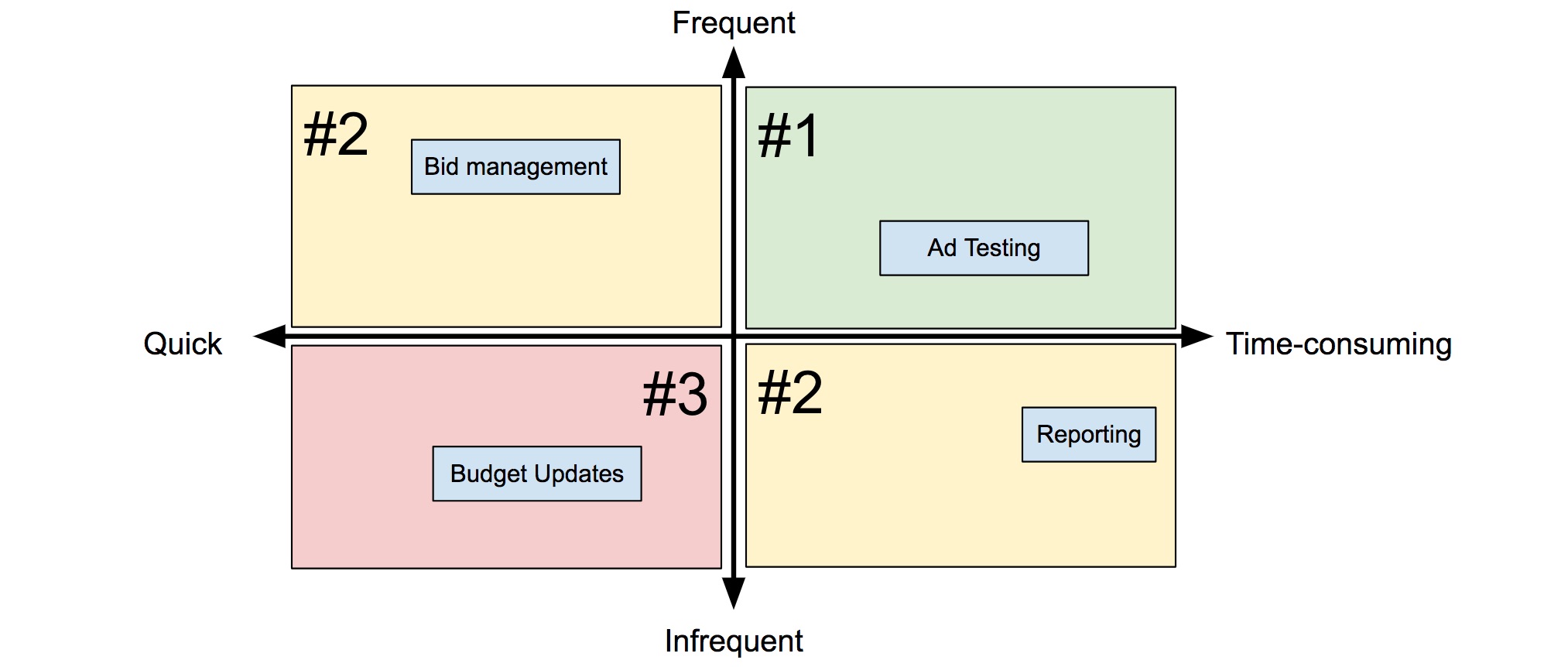Artificial Intelligence (AI) in paid search marketing is going to be big this year.
AI is one of several PPC trends that experts point out will gain steam in the next year.
While anyone can leverage AI by using Google’s toolset for AdWords, building your own AI can be daunting, especially if you haven’t even made a lot of inroads in PPC automation.
So how can we get started on the path to improving our campaigns with AI?
Let’s make it a New Year’s resolution.
I read that one way to achieve New Year’s resolutions is to make them more attainable.
So while AI is the trendy topic in PPC, let’s start off the year with a more attainable goal that will get us on the right path. Let’s commit to adding some new form of automation to our PPC accounts.
Create a Simple AI Without Writing Code
Early versions of AI were based on hard coding lots of rules into a program.
The goal was to fully cover all possible scenarios and hence build a system that could make intelligent decisions in any situation.
That approach to general AI ran out of steam due to the fact that the real world is hard to describe in a set of clean rules. And even if all situations could be identified, combinatorial explosion makes it hard to write software that reacts to real-world scenarios in an acceptably quick manner.
Nowadays, a lot of AI are expert systems, meaning they are built to handle a specific task very well.
Instead of general AI, which might have the goal of managing all of AdWords, narrow AI seeks to solve a specific (narrow) problem, so its goal could be to help manage budgets.
So rather than setting ourselves a goal of automating an entire AdWords account, let’s automate some portion of it.
By going for a narrow AI solution, we’re making this resolution even more attainable.
And how could we do this without writing code? I’ll cover that in the section on Automated Rules under “How to Automate.”
What Can Be Automated in PPC
Tasks that are well-defined can generally be automated.
So if you follow the same process every time you’re managing bids, setting budgets, or finding new keywords to add as single-keyword ad groups (SKAGs), you can automate it in AdWords.
A good way to check if your process is tightly defined is to think about whether you could outsource a task. Yes, it’s not automation, but if someone else takes the work off your plate, it’s almost as good.
The reason to add true automation is that computers and software don’t need breaks and can work for you 24/7, and they won’t make mistakes because of distractions. So if your task could be done by another person and they wouldn’t have to ask you questions about what to do, it can be automated.
And even tasks that require some human involvement may actually lend themselves to automation. Think about a process for ad testing.
While there’s an element of variability that requires a human touch when writing new ads, many of the steps leading up to that point are probably highly structured and could be automated.
-
 Ad testing may seem like something that’s difficult to automate. But if you break the task down into its components, you may find that many parts can in fact be automated and save you a ton of time.
Ad testing may seem like something that’s difficult to automate. But if you break the task down into its components, you may find that many parts can in fact be automated and save you a ton of time.
What’s Worth Automating
Here’s a way to decide what should be automated.
Draw a grid where the x-axis shows how time consuming a task is and the y-axis shows how often you do a task.
Then add your PPC work onto the grid to help you figure out what to prioritize for automation.
The longer it takes and the more you do it, the bigger the benefit from automating it.

How to Automate
Now for the part that I like best… let’s figure out exactly how we turn an idea for an automation into reality.
1. Bid Rules
The simplest form of automation is to use a pre-built tool from Google, like automated bid management.
If you want to automate a simple ‘bid to top of page’ rule, AdWords can do that.
You don’t need to build anything, and you don’t have to pay anything to use a bid strategy from AdWords.
But decisions about PPC aren’t always black and white.
Perhaps you want to bid your ads to the top of the page, but only if the keyword has a good Quality Score and is driving conversions at a reasonable CPA.
Perhaps you have different rules for brand and non-brand keywords.
Now a simple bid rule from Google may no longer suffice and we need to consider an alternative from the next few options below.
2. Automated Rules
The next level of automation is through Automated Rules which offers a bit more flexibility, yet it’s still a Google tool so it’s free to use.
This one requires a bit more thought though.
Automated Rules are great for relatively simple automations.
As someone who studied engineering in college, I find myself guilty of sometimes getting too excited about an opportunity to write lots of code when a simpler solution was right in front of me. One time I spent a day writing some custom code to help me turn on and off a set of ads for the weekends only to realize that this could have been done in minutes with Automated Rules.
Google lets advertisers run their rules up to once per day. Unfortunately that simply isn’t frequent enough to cover some common things advertisers want to do (e.g., checking budgets).
So let’s look at Scripts, the next level of automation for AdWords.
3. AdWords Scripts
Automations with Scripts are a lot more powerful and customizable.
AdWords Scripts are pieces of AppScript (a flavor of JavaScript with lots of shortcuts for interacting with Google’s systems like Gmail, Spreadsheets, and AdWords) that are hosted in an AdWords account and that can run on an automated schedule as often as once per hour.
Scripts are one of my favorite capabilities and I’ve written many over the years that advertisers can use for free.
Scripts are awesome for prototyping ideas and running automations on a handful of average sized AdWords accounts.
But scripts have limits too, especially when you want to run the same automation on more than 50 accounts, or if those accounts are very large and there’s more work than can be done in the 30-minute execution time limit imposed by Google.
There are workarounds for both of these restrictions, but if you start hitting these with some frequency, it may be time to consider the next level of automation, the ads API.
4. AdWords API
The AdWords application programming interface (API) gives developers programmatic access to AdWords.
It’s even the same way that Google’s own developers access AdWords data in the interfaces they’re building.
While the API doesn’t give access to every part of AdWords, it’s as close as we can get today.
Using the API requires some serious engineering resources as well as maintaining the servers to run it.
My company sometimes builds a proof-of-concept for an automation as a script because it requires less technical overhead, and if we see that customers like what we’ve created, we move the solution onto the API where it’s more scalable and can have a better user interface. But until we know it’s worth the extra effort involved in working with the API, we often stick with AdWords Scripts.
5. AI
Ultimately we all want to get to a place where we can leverage the latest and greatest algorithms to boost our account performance.
A lot of that cutting edge stuff is driven by AI and machine learning.
For now, I’ll just mention that AI and machine learning are components that you can add to your own automations later on – for example, by doing some of the calculations through the Google Cloud Prediction API.
Conclusion
Artificial Intelligence is pervasive in some of the tools AdWords provides its advertisers but it can also be built into automations advertisers create for themselves with their own business data.
But getting to the holy grail of amazing account performance through AI is a stretch goal for many.
So I hope you’ll join me in setting a goal of automating more of your PPC this year, to get on the path to AI, and to free up your time to work on more strategic things.
More PPC Resources Here:
- 25 Experts on the Big PPC Trends You Need to Know in 2018
- How to Use Automation to Boost PPC Performance
- Top 8 Ideas to Optimize Your PPC Performance
Image Credits
In-Post Photos: Frederick Vallaeys





